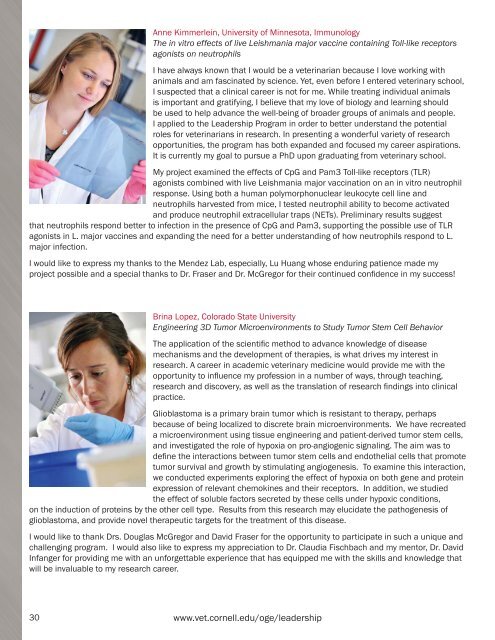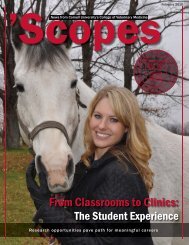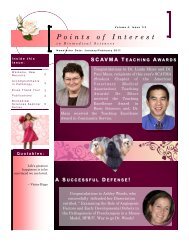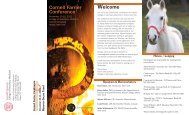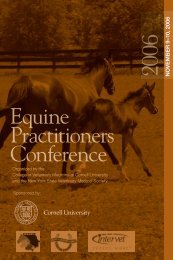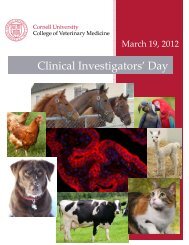2010 (PDF) - The College of Veterinary Medicine at Cornell University
2010 (PDF) - The College of Veterinary Medicine at Cornell University
2010 (PDF) - The College of Veterinary Medicine at Cornell University
Create successful ePaper yourself
Turn your PDF publications into a flip-book with our unique Google optimized e-Paper software.
Anne Kimmerlein, <strong>University</strong> <strong>of</strong> Minnesota, Immunology<br />
<strong>The</strong> in vitro effects <strong>of</strong> live Leishmania major vaccine containing Toll-like receptors<br />
agonists on neutrophils<br />
I have always known th<strong>at</strong> I would be a veterinarian because I love working with<br />
animals and am fascin<strong>at</strong>ed by science. Yet, even before I entered veterinary school,<br />
I suspected th<strong>at</strong> a clinical career is not for me. While tre<strong>at</strong>ing individual animals<br />
is important and gr<strong>at</strong>ifying, I believe th<strong>at</strong> my love <strong>of</strong> biology and learning should<br />
be used to help advance the well-being <strong>of</strong> broader groups <strong>of</strong> animals and people.<br />
I applied to the Leadership Program in order to better understand the potential<br />
roles for veterinarians in research. In presenting a wonderful variety <strong>of</strong> research<br />
opportunities, the program has both expanded and focused my career aspir<strong>at</strong>ions.<br />
It is currently my goal to pursue a PhD upon gradu<strong>at</strong>ing from veterinary school.<br />
My project examined the effects <strong>of</strong> CpG and Pam3 Toll-like receptors (TLR)<br />
agonists combined with live Leishmania major vaccin<strong>at</strong>ion on an in vitro neutrophil<br />
response. Using both a human polymorphonuclear leukocyte cell line and<br />
neutrophils harvested from mice, I tested neutrophil ability to become activ<strong>at</strong>ed<br />
and produce neutrophil extracellular traps (NETs). Preliminary results suggest<br />
th<strong>at</strong> neutrophils respond better to infection in the presence <strong>of</strong> CpG and Pam3, supporting the possible use <strong>of</strong> TLR<br />
agonists in L. major vaccines and expanding the need for a better understanding <strong>of</strong> how neutrophils respond to L.<br />
major infection.<br />
I would like to express my thanks to the Mendez Lab, especially, Lu Huang whose enduring p<strong>at</strong>ience made my<br />
project possible and a special thanks to Dr. Fraser and Dr. McGregor for their continued confi dence in my success!<br />
Brina Lopez, Colorado St<strong>at</strong>e <strong>University</strong><br />
Engineering 3D Tumor Microenvironments to Study Tumor Stem Cell Behavior<br />
<strong>The</strong> applic<strong>at</strong>ion <strong>of</strong> the scientifi c method to advance knowledge <strong>of</strong> disease<br />
mechanisms and the development <strong>of</strong> therapies, is wh<strong>at</strong> drives my interest in<br />
research. A career in academic veterinary medicine would provide me with the<br />
opportunity to infl uence my pr<strong>of</strong>ession in a number <strong>of</strong> ways, through teaching,<br />
research and discovery, as well as the transl<strong>at</strong>ion <strong>of</strong> research fi ndings into clinical<br />
practice.<br />
Glioblastoma is a primary brain tumor which is resistant to therapy, perhaps<br />
because <strong>of</strong> being localized to discrete brain microenvironments. We have recre<strong>at</strong>ed<br />
a microenvironment using tissue engineering and p<strong>at</strong>ient-derived tumor stem cells,<br />
and investig<strong>at</strong>ed the role <strong>of</strong> hypoxia on pro-angiogenic signaling. <strong>The</strong> aim was to<br />
defi ne the interactions between tumor stem cells and endothelial cells th<strong>at</strong> promote<br />
tumor survival and growth by stimul<strong>at</strong>ing angiogenesis. To examine this interaction,<br />
we conducted experiments exploring the effect <strong>of</strong> hypoxia on both gene and protein<br />
expression <strong>of</strong> relevant chemokines and their receptors. In addition, we studied<br />
the effect <strong>of</strong> soluble factors secreted by these cells under hypoxic conditions,<br />
on the induction <strong>of</strong> proteins by the other cell type. Results from this research may elucid<strong>at</strong>e the p<strong>at</strong>hogenesis <strong>of</strong><br />
glioblastoma, and provide novel therapeutic targets for the tre<strong>at</strong>ment <strong>of</strong> this disease.<br />
I would like to thank Drs. Douglas McGregor and David Fraser for the opportunity to particip<strong>at</strong>e in such a unique and<br />
challenging program. I would also like to express my appreci<strong>at</strong>ion to Dr. Claudia Fischbach and my mentor, Dr. David<br />
Infanger for providing me with an unforgettable experience th<strong>at</strong> has equipped me with the skills and knowledge th<strong>at</strong><br />
will be invaluable to my research career.<br />
30 www.vet.cornell.edu/oge/leadership


